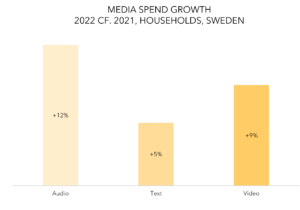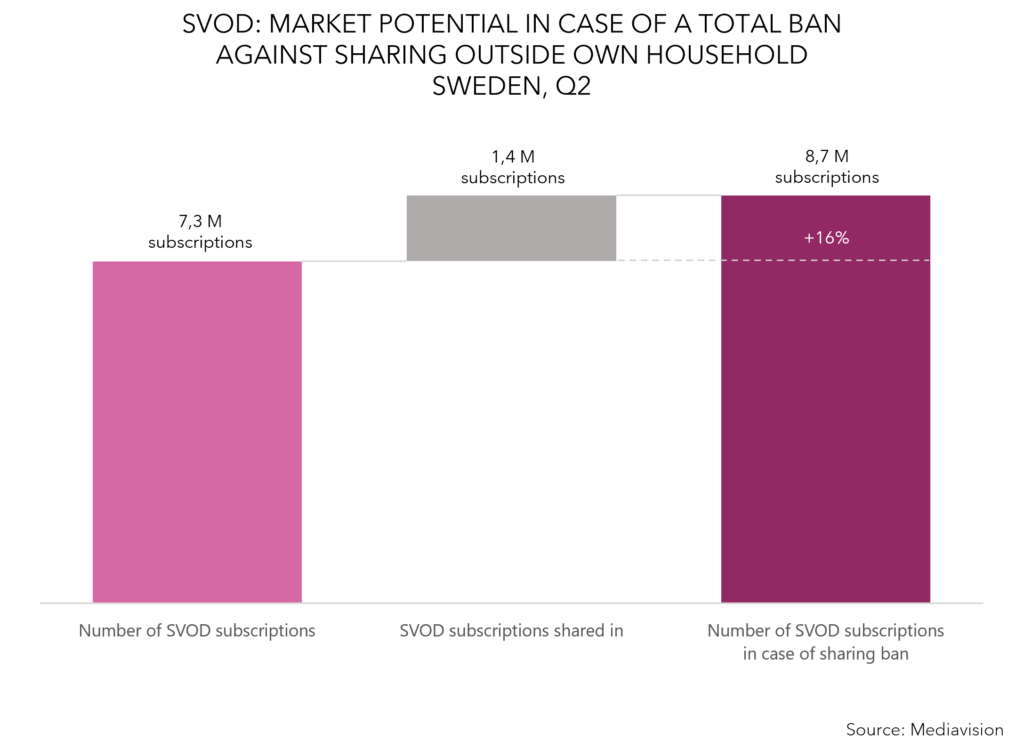Swedish media is mainly financed by advertising and consumer payments. The advertising market is largely affected in an economic downturn. However, Mediavision can show that households’ interest in paying for media, for example through subscriptions, continues to increase – despite the economic decline. For many media companies, consumer revenues will increase in importance if Sweden enters a recession.
Swedish household media spend has gradually increased and despite economic concerns, 2022 was no exception. Average media spend increased 8 percent compared to 2021, and now amounts to SEK 685 per month. Looking across the three main categories text, audio and video1, audio services increased the most, with a whopping 12 percent. At the same time, text grew by 5 percent and video by 9 percent compared to 2021. For the advertising market, development was significantly weaker and, according to IRM, a decrease of just over 2 percent was noted in the last quarter of the year, compared to the same period in 2021.

For advertising revenue in 2023, IRM expects a continued decline of 0.7 percent. For consumer payments, Mediavision currently sees no signs of a similar decline. On the contrary, preliminary data for the first months of the year shows continued growth. Bottom line is that consumer payments are stable or increasing, despite economic instability. When consumers are asked about their plans in financially tougher times, other expenses than media are opted out first.
– We recognize this pattern from previous economic downturns. Household spend on media is more stable than advertising revenue, comments Marie Nilsson, CEO at Mediavision. Therefore, it is particularly important in these times to closely monitor, for example, customer satisfaction and price sensitivity. Bundling different types of media services can also be a way to strengthen the relationship with consumers.
¹Text: Digital/printed newspapers, magazines and books (subscription and purchase per unit) Audio: audiobooks, music and podcasts (subscription and purchase per unit) Video: Trad. TV, SVOD, TVOD, cinema and DVD/Blu-ray.
Sharing SVOD subscriptions is a widespread phenomenon. At the turn of the year, approximately 1.4 million SVOD accounts were used by people outside of the paying household. This has become a growing concern for streaming actors as it hampers growth. Several companies are now reviewing the possibilities of limiting sharing. Theoretically, those that share today could contribute to continued growth, if they were transformed to paying customers. If they would pay the same average price av everyone else, Mediavision estimates the value of today’s forgone revenues to approx SEK 900 million (excl. VAT) per year.
In Sweden, close to 1.4 million SVOD subscriptions were shared outside the paying household at the turn of the year. Almost half of everyone with a SVOD subscription shares at least one subscription with someone outside the household. If sharing was stopped, the SVOD market could potentially grow up to 16 percent compared to today. The number of subscriptions would then increase from today’s 7.3 million to 8.7 million. Based on average household spend on stand-alone streaming subscriptions, the lost revenue is estimated to a value of close to SEK 900 million per year (excluding VAT).

Netflix was the first actor to take actions on account sharing, but Disney is also reviewing its sharing policy. For the companies, the hope is that this will accelerate growth, especially in households that have already shown interest in the services. But Mediavision’s analysis also points to risks. A ban on sharing may mean that some paying households actually leave the service all together.
– Almost half of all SVOD households in Sweden share at least one subscription outside the household, which shows how widespread the phenomenon is, comments Marie Nilsson, CEO of Mediavision. Many have made a habit of this and if the households are “forced” to prioritize, the risk of services being opted out increases. However, it is likely that all actors will review password sharing, which will possibly lead to both increased customer movement and more customers for the SVOD services.
